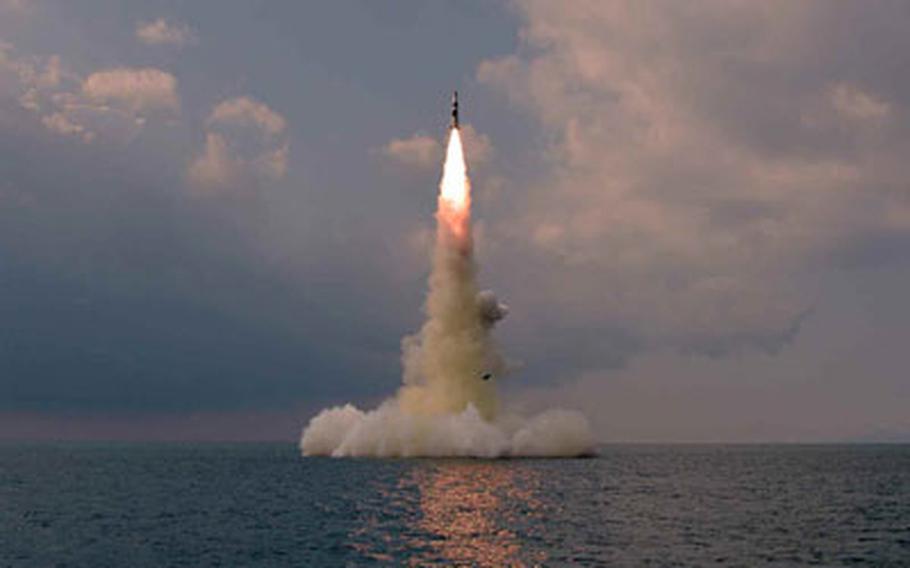
This photo released by the Korean Central News Agency show a submarine-launched ballistic missile test by North Korea, Tuesday, Oct. 19, 2021. (KCNA)
CAMP HUMPHREYS, South Korea — North Korea says its test of a “new type” of submarine-launched ballistic missile earlier this week should be considered “normal activities” for the country, and that it posed no threat to the United States.
A spokesperson for North Korea’s Ministry of Foreign Affairs reiterated that the launch was a defensive measure, a claim the communist regime frequently makes to justify its nuclear and ballistic missile tests, according to a statement released Thursday by the state-run Korean Central News Agency.
The test “was part of the normal activities for carrying out the medium and long-term plan for the development of defense science and it did not pose any threat or damage to the security of the neighboring countries and the region,” the spokesperson said through KCNA.
The statement added that “we did not have the U.S. in mind nor aimed at it” and that “there is no need for the U.S. to worry or trouble itself over the test-firing.”
South Korean military officials assessed that a short-range ballistic missile flew 279 miles at a maximum altitude of 37 miles at 10:17 a.m. Tuesday. The Japan Coast Guard, however, said two missiles were fired from North Korea’s eastern coast.
The missile appeared to have been launched from Sinpo, according to South Korean military officials, where a North Korean shipyard is believed to be working on a new ballistic missile submarine. The North last conducted an SLBM test from an underwater platform in 2019, and claims it fired a separate SLBM from an outdated submarine in 2016.
Experts have widely remained skeptical of North Korea’s claims of self-defense, particularly with the development of its SLBM program. The missiles are typically viewed as retaliatory, second-strike weapons due to the difficulty in detecting submarines prior to a launch.
Sea-based missiles are “more survivable and more difficult to destroy through pre-emptive attack than land-based systems,” Ankit Panda, a North Korea analyst and Stanton senior fellow at the Carnegie Endowment for International Peace, said Wednesday.
Pyongyang’s latest missile launch is the fifth weapons test in recent weeks. In September and so far in October it has launched an anti-aircraft missile, a ballistic missile from a train, long-range cruise missiles capable of reaching Japan and a hypersonic short-range missile.
The U.N. Security Council held a closed-door meeting Wednesday to discuss the most recent launch. The U.S. and several other member nations condemned the test, calling it “the latest in a series of reckless provocations.”
“These are unlawful activities,” U.S. Ambassador to the U.N. Linda Thomas-Greenfield said in a statement. “They are in violation of multiple Security Council resolutions. And they are unacceptable.”
Thomas-Greenfield did not say whether the council was considering additional sanctions against North Korea and said “we just need to be more serious about the implementation” of existing sanctions.
South Korean Foreign Minister Chung Eui-yong during a parliamentary briefing Wednesday appeared to rebuff the notion of imposing additional sanctions, saying that “sanctions relief" may be taken into consideration to bring North Korea to the negotiation table.